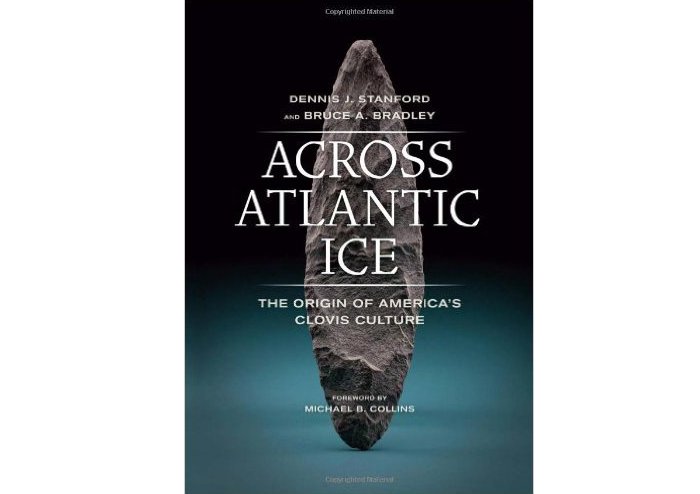Solutrean People: Were First Americans European Stone Age People?
Ellen Lloyd - AncientPages.com - Who were the first Americans? This question remains an unanswered and much-debated question. There are several promising theories, but several scientists say conclusive evidence is still missing.
Cro-Magnon artists painting in Font-de-Gaume,1920. Image: Charles R. Knigh
According to the Solutrean hypothesis, the first Americans were Stone Age Europeans who came to North America several thousand years earlier than the Ice bridge theory proposes.
The intriguing Solutrean theory raises a number of questions, such as: Where did these Europeans come from, and what happened to them? What evidence is there to support this claim?
The most widely accepted scientific theory is that sometime before 14,000 years ago, humans migrated from Siberia to Alaska using a "land bridge" that spanned the Bering Strait.
However, some scientists question the Land Bridge theory. One of them is the Smithsonian Institution anthropologist and Professor Dennis Stanford and Professor Bruce Bradley from Exeter University, who wrote the book Across Atlantic Ice: The Origin of America's Clovis Culture.
Smithsonian Institute anthropologist Dennis Stanford, left, and University of Exeter archaeologist Bruce Bradley examine knives from the last Ice Age. (Bonnie Jo Mount/Post)
Professors Stanford and Bradley believe that ancient Europeans traveled to North America across an Atlantic frozen by the Ice Age. They base their theory on stone tools discovered by archaeologists along the northeast coast of the USA.
These ancient tools are between 19,000 and 26,000 years and bear remarkable similarities to those made in Europe.
Professor Stanford said these mysterious Stone Age Europeans were known as the Solutreans, and they occupied Spain, Portugal, and southern France more than 20,000 years ago.
They paddled along an ice cap jutting into the North Atlantic and lived like Inuits, harvesting seals and seabirds.
'Ice Bridge Theory'
In time, the Solutreans spread across North America, hauling their distinctive blades with them and giving birth to the later Clovis culture, which emerged some 13,000 years ago.
According to archaeologist and paleontologist James Chatters, modern Native Americans closely resemble people of China, Korea, and Japan, but the oldest American skeletons do not. "This has led to speculation that perhaps the first Americans and Native Americans came from different homelands," Chatters said, "or migrated from Asia at different stages in their evolution."
Could these people have come from Europe?
On Chesapeake Bay islands, scientists unearthed blades, anvils, and other tools found stuck in the soil at least 20,000 years old. Professor Stanford said these ancient blades strongly resemble those found at dozens of Solutrean sites from the Stone Age in Spain and France.
The Solutreans left behind rock art, but no skeletons have been found, so unfortunately, no DNA is available to study.
Professor Stanford's theory has been met with criticism. When Professor Stanford proposed this "Solutrean hypothesis" in 1999, his colleagues rejected it. One prominent archaeologist suggested that Stanford was throwing his career away.
Who were the first humans to inhabit North America? According to the now familiar story, mammal hunters entered the continent some 12,000 years ago via a land bridge that spanned the Bering Sea. Distinctive stone tools belonging to the Clovis culture established the presence of these early New World people. But are the Clovis tools Asian in origin? Drawing from original archaeological analysis, paleoclimatic research, and genetic studies, noted archaeologists Dennis J. Stanford and Bruce A. Bradley challenge the old narrative and, in the process, counter traditional—and often subjective—approaches to archaeological testing for historical relatedness. The authors apply rigorous scholarship to a hypothesis that places the technological antecedents of Clovis in Europe and posits that the first Americans crossed the Atlantic by boat and arrived earlier than previously thought. Supplying archaeological and oceanographic evidence to support this assertion, the book dismantles the old paradigm while persuasively linking Clovis technology with the culture of the Solutrean people who occupied France and Spain more than 20,000 years ago. Read more
His theory has been revived many years later, and more scientists are curious and willing to investigate the Solutrean hypothesis further.
"The reason people don't like the Solutrean idea is the ocean," Professor Stanford said. No Solutrean boats have been found. But given that people arrived in Australia some 60,000 years ago — and they didn't walk there — wood-frame and seal-skin boats were possible, Stanford argued.
Scientists also point out that another problem with the Solutrean hypothesis is that at the end of the last ice age, the polar ice cap may not have extended all the way across the Atlantic, leaving iceberg-strewn gaps of open water for the Solutreans to navigate as they headed West for unknown reasons.
Many scientists think the Solutreans hypothesis is based on scant evidence, but it is naturally an interesting hypothesis that is worth exploring if one wants to learn more about the first Americans.
Written by - Ellen Lloyd – AncientPages.com
Updated on February 6, 2023
Copyright © AncientPages.com All rights reserved. This material may not be published, broadcast, rewritten or redistributed in whole or part without the express written permission of AncientPages.com
Expand for referencesMore From Ancient Pages
-
 Patara Lighthouse Built By Emperor Nero In 64 AD Will Shine Again
Archaeology | Mar 5, 2020
Patara Lighthouse Built By Emperor Nero In 64 AD Will Shine Again
Archaeology | Mar 5, 2020 -
 On This Day In History: Battle Of Naulochus Was Fought Off The Coast Of Sicily – On Sep 3, 36 BC
News | Sep 3, 2015
On This Day In History: Battle Of Naulochus Was Fought Off The Coast Of Sicily – On Sep 3, 36 BC
News | Sep 3, 2015 -
 Chennakeshava Temple In Belur Is Richly Decorated With Scenes From Ramayana Mahabharata And Puranas
Featured Stories | Nov 18, 2021
Chennakeshava Temple In Belur Is Richly Decorated With Scenes From Ramayana Mahabharata And Puranas
Featured Stories | Nov 18, 2021 -
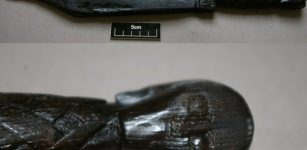 Extraordinary 1,000-Year-Old Viking Sword Discovered In Cork, Ireland
Archaeology | Sep 29, 2017
Extraordinary 1,000-Year-Old Viking Sword Discovered In Cork, Ireland
Archaeology | Sep 29, 2017 -
 Nabopolassar: Father Of Nebuchadnezzar II And King Of Babylon Rose To Power Thanks To His Dedication To Gods Nabu And Marduk
Featured Stories | Jan 11, 2019
Nabopolassar: Father Of Nebuchadnezzar II And King Of Babylon Rose To Power Thanks To His Dedication To Gods Nabu And Marduk
Featured Stories | Jan 11, 2019 -
 Lamplighters In London: An Important Job In The Victorian Era
Ancient History Facts | May 17, 2019
Lamplighters In London: An Important Job In The Victorian Era
Ancient History Facts | May 17, 2019 -
 New Evidence Reveals That Humans Settled In Americas At Least 13,000 Years Ago
Archaeology | Sep 4, 2017
New Evidence Reveals That Humans Settled In Americas At Least 13,000 Years Ago
Archaeology | Sep 4, 2017 -
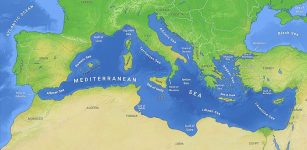 Mediterranean Migration Was Low Over 8,000 Years – New Study
Archaeology | Mar 3, 2021
Mediterranean Migration Was Low Over 8,000 Years – New Study
Archaeology | Mar 3, 2021 -
 Were Neanderthals Really As Well Adapted To A Life In The Cold As Previously Assumed? New Study
Archaeology | Apr 26, 2022
Were Neanderthals Really As Well Adapted To A Life In The Cold As Previously Assumed? New Study
Archaeology | Apr 26, 2022 -
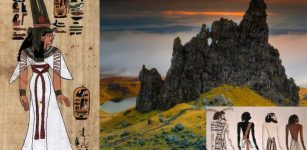 Ancestors Of The Irish And Scots Came From Biblical Lands And Ancient Egypt – Myths, History And DNA
Civilizations | Jul 14, 2020
Ancestors Of The Irish And Scots Came From Biblical Lands And Ancient Egypt – Myths, History And DNA
Civilizations | Jul 14, 2020 -
 What Does The Brain Of The Homo Erectus Fossil With The Lowest Cranial Capacity Tell About Evolution?
Archaeology | Mar 2, 2023
What Does The Brain Of The Homo Erectus Fossil With The Lowest Cranial Capacity Tell About Evolution?
Archaeology | Mar 2, 2023 -
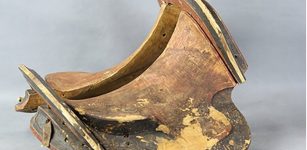 World’s Oldest Known ‘True’ Saddle Discovered In East Asia
Archaeology | Dec 11, 2023
World’s Oldest Known ‘True’ Saddle Discovered In East Asia
Archaeology | Dec 11, 2023 -
 Unique Ancient Roman Boxing Gloves Discovered Near Hadrian’s Wall – The Only Surviving Example From 120 A.D.
Archaeology | Feb 20, 2018
Unique Ancient Roman Boxing Gloves Discovered Near Hadrian’s Wall – The Only Surviving Example From 120 A.D.
Archaeology | Feb 20, 2018 -
 Encounter With Time Window At The Upper Current River And Curious Glimpses From The Past
Featured Stories | Jul 28, 2018
Encounter With Time Window At The Upper Current River And Curious Glimpses From The Past
Featured Stories | Jul 28, 2018 -
 Copiale Cipher – Secrets Of Mysterious Coded Manuscript And The Oculist Order
Artifacts | Feb 4, 2019
Copiale Cipher – Secrets Of Mysterious Coded Manuscript And The Oculist Order
Artifacts | Feb 4, 2019 -
 Riddle Of The Indo-European Language – Which Of The Two Hypotheses Is Correct?
Featured Stories | Oct 25, 2023
Riddle Of The Indo-European Language – Which Of The Two Hypotheses Is Correct?
Featured Stories | Oct 25, 2023 -
 Stunning Ancient Khanqah With Large Underground Crypt, Ritual Halls And Burials Discovered In Turkestan
Archaeology | Aug 14, 2020
Stunning Ancient Khanqah With Large Underground Crypt, Ritual Halls And Burials Discovered In Turkestan
Archaeology | Aug 14, 2020 -
 On This Day In History: Eugène Dubois Who Discovered Remains Of Java Man Was Born – On Jan 28, 1858
News | Jan 28, 2017
On This Day In History: Eugène Dubois Who Discovered Remains Of Java Man Was Born – On Jan 28, 1858
News | Jan 28, 2017 -
 Vast Network Of Previously Unknown European Bronze Age Megastructures Discovered
Archaeology | Nov 20, 2023
Vast Network Of Previously Unknown European Bronze Age Megastructures Discovered
Archaeology | Nov 20, 2023 -
 Lady Cao – Moche Queen Who Re-Wrote Ancient History
Civilizations | Jan 12, 2018
Lady Cao – Moche Queen Who Re-Wrote Ancient History
Civilizations | Jan 12, 2018




